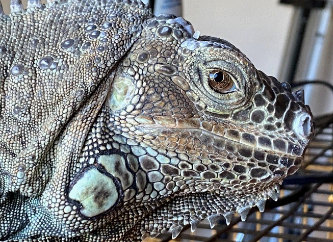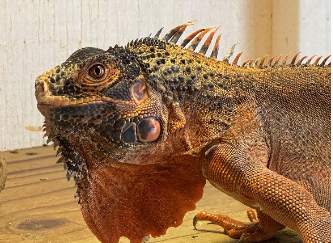Hello, out there, friends and fans! It’s me, Curtis Curly-tail!
Today, I wanted to ask you if you knew that Green Iguanas, Iguana iguana, come in different colors? And, if they come in different colors, how do you tell if a lizard is a green iguana?
You look for the subtympanic scale. “What is that?” you ask. Well, I don’t have one, so I had to look it up myself. The subtympanic scale is that large scale on the side of the green iguana’s head. Sub means below and tympanic means ear. So, it’s the big scale below the ear. I have a friend who calls that scale the “jewel.” She always admires the beautiful coloring in the iguana jewels.

Here are some of my green iguana friends, in very different colors. As you can see, they are not just green–but they are all still called “green.” Even the green green iguanas come in different shades of green. It can be confusing, if you ask me.
The native range of the green iguana is southern Mexico to central Brazil and several Caribbean islands. If you don’t live in those areas, why should you know how to identify a green iguana? Because they’re very popular as pets in people’s homes and they have been introduced to many other places in the world, where they don’t belong and can be causing harm. That means they’re “invasive.”


If you want to know the differences between a green iguana and their cousins, the rock iguanas, Lyric Power Publishing, LLC has several identification booklets to help you tell them apart.
If you enjoy learning while coloring and doing activities, I encourage you to be creative. To learn more in fun ways about iguanas, please see our 30-page workbook full of activity sheets about iguanas, My Unit Study on Iguanas. Remember that the green iguanas you color, don’t have to be green!

